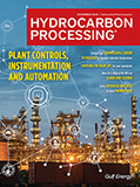Analyzers
How to support condition monitoring with wireless instrumentation networks
When <i>Wireless</i>HART first hit the market in 2008, most of the native devices using it were process measurement instruments.
Applying tools to strengthen safety and risk management
The same characteristics that make hydrocarbons useful as fuels can also make refineries, and any other areas where processing or storage takes place, potentially dangerous.
Digital: Harnessing the power of digital platforms to improve plant performance and increase customer success
Digital online platforms offer significant potential benefits across the oil and gas value chain by employing advanced analytical tools and near-real-time access to technical expertise to improve day-to-day plant performance.
Virtual analyzers: Shaping the future of product quality
Product quality directly drives price and where hydrocarbons can be delivered.
Achieve refinery cost savings with real-time hydrogen monitoring
As stay-at-home orders and state mandates to shelter in place made waves around the globe in early 2020, nearly every industry was severely impacted by the COVID-19 pandemic.
Editorial Comment: Optimizing operations by advancing process controls, instrumentation and automation technologies
When driving by or visiting a refinery or petrochemical plant, one cannot help but gaze at the expansive sea of metal towers.
Extracting business value from digitalization in oil and gas
Most oil and gas companies are investing in digitalization; however, they often fail to move beyond proof of value (PoV) or pilot projects.
Increase uptime by reducing systematic failure risk
Pondering the history of industrial incidents, it would be incorrect to assume that most failures occur randomly.
Automation: Significant improvement of soft sensor estimation by automation in bias correction
The main objective of any industry is to operate as close as possible to the point where profits are maximized.
Safety: Addressing corrosion at petrochemical plants starts with carbon
Maintaining the structural integrity of a pipeline is a significant investment of time and resources for organizations in the oil and gas industry.

- ITT to acquire SPX Flow for > $4.77 B, expanding leadership in highly engineered components and adjacent flow technologies 12/5
- MOL Group introduces eco-friendly Bag-in-Box packaging for lubricants 12/5
- Addis Energy secures $8.3 MM to scale its transformative approach to low-cost ammonia production 12/5
- World Fuel Services supplies cruise line with waste-based biofuels 12/5
- Chevron announced $18 B-$19-B CAPEX budget for 2026 12/5
- Russia and India sign deal to build urea plant in Russia 12/5




